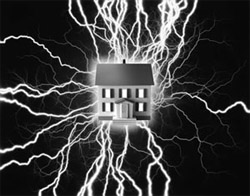
Shunt Mode Surge Suppressors
Shunt Mode surge suppressors operate by redirecting (shunting) incoming surge energy onto their associated EG conductors, with the result that the local ground reference potential rises due to the current flow through the impedance of the circuit path back to Building Ground.
For a ground path length of more than a few feet, this impedance can be substantial, resulting in significant voltages with respect to other “grounded” areas in the building.
Any and all equipment connected to a Shunt Mode surge protection device will thus experience an abrupt elevation of its local EG reference potential during surge events.
For non-networked standalone applications this may be an academic issue. The additional drawbacks described below are considerably more serious, however.
MOV’s
Metal Oxide Varistors (MOV’s), the principal component(s) which divert incoming surge energy into EG conductors in virtually all Shunt Mode surge suppressors, exhibit a “fixed clamping voltage” characteristic, above which they rapidly change from virtual open circuits into low resistance conductors.
For a transient surge duration of not more than a few milliseconds, the resulting power dissipation in MOV’s can be tolerated. In the event of a continuous overvoltage condition of any significant duration however, MOV’s rapidly heat up and then either permanently revert to their non-conductive state, or fail catastrophically with the attendant possibility of fire.
Irrespective of cost or manufacturer, the cumulative (sacrificial) effect of repeated surges over time will ultimately cause MOV’s to fail one way or the other. Recent MOV-based surge suppressor devices made to Underwriters Laboratories (UL) 1449–2 (2nd ed.) specifications incorporate a fuse element which disconnects the power in the event of catastrophic MOV failure.
Older MOV-based devices do not have this feature, however, and non-catastrophic MOV failure leaves the attached equipment completely unprotected, usually without the knowledge of the owner! To ensure continuously safe operation, MOV-based surge protection devices should be tested on a regular basis.
Shunt Mode Surge Suppressors In Equipment Networks
It is not uncommon to encounter “Shunt Mode surge protected” equipment interconnected by network cables to other equipment elsewhere in a building which, for whatever reason are NOT connected to Shunt Mode surge suppressors.
During a surge event, “unprotected” equipment will experience little if any elevation of its ground reference potential, whilst “protected” equipment will experience an abrupt and often substantial rise in its ground reference potential.
The resulting surge currents flowing in network cable ground loops are thus considerably increased by the use of Shunt Mode surge suppressors at only one or some equipment locations•rather than all locations involved in the network.
Installing identical Shunt Mode suppressors at all equipment locations may reduce the magnitude of this problem, but only to the extent that the impedances of each ground path into which noise energy is shunted are the same, a condition which is not likely to exist in all but the smallest of systems.
